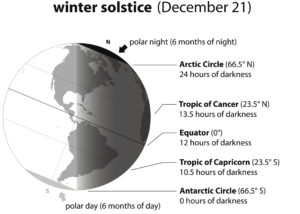
The month of December has been the final month of the calendar year for many centuries. The name “December” comes from the Latin word decem, meaning “ten.” This is due to the fact that this month was considered the tenth and last month of the year when the Julian calendar model was established in Rome. Over the course of time, the Julian calendar fell to the wayside for the Gregorian calendar, and this caused dates to be changed and months added to flesh out the year.
Though these changes took December out of its spot as the tenth month of the year, it kept its placement as the final month of the year. Because of this, many celebrations have taken place in this month. One of the more important holidays observed in December is the winter solstice. Though observed for different reasons, this event helped to set the table for future celebrations like Yuletide and, eventually, Christmas.
The Solstice
Throughout much of humanity’s history, holidays and celebrations were dictated by the placement of the stars. Early astronomers, scholars, and religious leaders determined events like the solstice of winter to be of utmost importance. All across Europe, various peoples observed and celebrated around this time. For some, like the Norse, the solstice was a time to come together with family and friends to feast and enjoy the simple pleasures of life. Some texts from this time also suggest it was a time of great sacrifice for many, as the coming winter could hold many potential dangers.
Though basing a religious event around the placement of the stars can seem odd to some modern thinkers, there is actually scientific basis for all of it. The winter solstice marks the time in the Northern Hemisphere when the Earth tilts on its axis away from the warming rays of the sun, creating the thickest and coldest part of the winter. Through this event, people would gather to pay homage to the sun and prepare for the long, dark days ahead.
Reason for the Season
Historians have a lot to say about how the winter solstice was celebrated and why it was a time of great joy and revelry. Winter was always quite harsh for the people of Northern Europe, especially in regard to food. Livestock would die off in the winter, and crops would be dormant until the season had passed, making famine quite common. The celebration of the winter solstice included a great deal of food and drink. Scholars believe this is due to how plentiful food was during the solstice.
Since people knew the winter would be hard to get through and many people might not see the spring, the winter solstice was a time to feel most alive. Eventually, these celebrations took on new life in parts of Scandinavia and became a holiday celebration known as Juul.
Juul to Yuel
The celebration of Juul was quite similar to how the winter solstice was observed by others across Europe. For Scandinavians, Juul was a holiday that lasted for twelve days and centered around worshipping the sun as it began its journey away for the winter. Eventually, Juul would be called Yuel, and it would be transformed once again when the Christians arrived in Scandinavia. The mix of Christianity and pagan beliefs helped to create many of the modern Christmas traditions that still exist, like putting a yule log in the fireplace.
The celebrations that take place in December are centered around light and joy in some way. Whether observing Christmas, Chanukah, or Kwanza, it stands to reason that candles and twinkling lights will be involved. Though there are many reasons for this, much of it comes back to the winter solstice and the journey of the sun.

